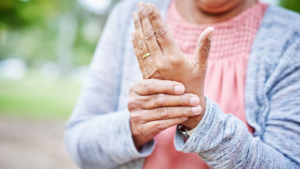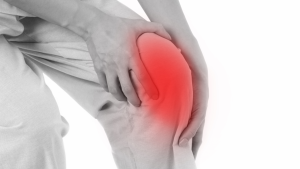Arthritis is the swelling and tenderness of the joints. It is a term used to describe over 200 types of joint conditions. Two of the main symptoms that are associated with arthritis are pain and stiffness.
Arthritis Pain
Arthritis pain can be debilitating. In fact, the CDC reports that over one-third of adults who suffer from arthritis are limited in their activities and work.
A few of the most common types of arthritis are osteoarthritis, psoriatic arthritis, and fibromyalgia. All three of these conditions cause different kinds of pain.

Pain and Stiffness Due to Arthritis
Osteoarthritis
Osteoarthritis causes the cartilage inside the joints to disintegrate. Cartilage acts as a cushion for your bones, so when this break down occurs, the bones of your joints may rub directly against one another. This causes severe pain. However, the pain caused by osteoarthritis varies from patient to patient, depending on location and severity.
Psoriatic Arthritis (PsA)
Psoriatic arthritis is an autoimmune disease. It causes the immune system to attack the body, resulting in inflammation and pain. Psoriatic arthritis can cause a variety of pain to different areas of the body. PsA affects the joints, which causes arthritis. Arthritis affects the soft tissue, tendons, and ligaments that attach to bones causing enthesitis. It can also affect the skin, which causes psoriasis.
Fibromyalgia
Fibromyalgia is a central pain syndrome. Central pain syndrome means your body and brain are affected by pain differently from others. A normal movement for others may cause you severe pain, or something that is painful for others may be excruciating for you. This pain can be widespread – meaning your whole body is affected. But fibromyalgia pain can come and go or be constant. It all depends on the patient.
Stiffness Caused by Arthritis
Joint stiffness is common in patients suffering from arthritis. This is because the stiffness is caused by inflammation. The inflamed area of a joint is typically worsened after periods of inactivity – especially prolonged sitting or standing. Stiffness is particularly common in the morning after a good night’s rest. However, the type of stiffness can be determined by the type of arthritis the patient has.
Rheumatic arthritis causes stiffness after a period of rest. This can occur after sitting for a long period of time, such as at a desk job or sitting in a movie theater. Standing up and walking slowly helps diffuse the stiffness.
Inflammatory arthritis causes a different kind of stiffness. This is temporary stiffness that lasts for a short amount of time. This is most common in arthritis patients in the morning, with the stiffness wearing off after approximately 30 minutes.
Get Relief from Your Pain and Stiffness
The length of time you feel joint pain and stiffness can help your physician determine the type of arthritis you have. Medication is not usually recommended, but the pain and stiffness can be reduced through the use of alternating hot and cold compresses, physical therapy, and exercise to increase your range of motion.
If you are living with arthritis and in daily pain, the team at Progressive Pain Management can help. Contact us today by filling out the form below.
Arthritis is a leading cause of pain and disability worldwide. In the United States alone, arthritis affects 50 million adults and over 300,000 children. Arthritis is not a single diagnosis, but in fact a collection of conditions that causes pain and aches related to joint paint.
Arthritis comes in a variety of forms and affects people differently – but the most common types are osteoarthritis and rheumatoid arthritis. And while over-the-counter medications and prescriptions can be effective, many patients do not want to take the risk of taking medication. There are many alternative methods for arthritis treatments that do not include taking pills or utilizing a prescription.

Finding Relief from Arthritis Pain
Treatments for Arthritis Pain Relief
-
The Right Pair of Shoes
According to a study, researchers found that in people with osteoarthritis, flexible shoes like flip-flops and sneakers reduce the force exerted on knee joints by an average of 13% compared to clogs and specialty shoes.
More force on joints equates more pain, so if by wearing flexible shoes there is less force, it should mean there is less pain. This is best to relieve pain in those who suffer from osteoarthritis of the knee and hip.
2. Aquatic Exercises
Water provides a resistance that increases the intensity of an exercise while also providing buoyancy that supports your bodyweight and relieving pressure on your joints.
Water aerobics and exercises have been proven to help improve range of motion, coordination, quality of life, and reduce body fat. While it may not be a long-term solution, patients who participate in aquatic exercises find relief from arthritis pain.
3. Yoga
Yoga, specifically Iyengar yoga that focuses on proper body alignment to support the body and relieve tension, is an excellent way to help relieve arthritis pain. Yoga is helpful in patients with rheumatoid arthritis in relieving pain, improving mood, and the ability to cope with their chronic arthritis pain.
- Supplements
Natural supplements are regularly being researched and approved for help in relieving pain associated with arthritis. Many supplements have properties that act as natural anti-inflammatories and the ability to stimulate neurotransmitters, like serotonin, which reduce pain receptors. Some supplements include:
- Indian Frankincense
- Tumeric
- Fish Oil / Omega 3
- Ginger
5. Massage
Regular massages help relieve tension and relax muscles and joints. Professional massages lower the body’s production of cortisol (the body’s stress hormone) and the neurotransmitter substance P, which is associated with pain. Massages help improve patients’ moods by boosting serotonin levels.
6. Therapy
Different kinds of therapy – exercise, physical, and cognitive behavioral therapies – are all beneficial to patients who suffer from arthritis pain. It improves your body’s strength, posture, range of motion, and functionality. Exercise is known to improve your mood, and when used in conjunction with cognitive behavioral therapy (CBT) it can be incredibly helpful in reducing pain.
CBT, or talk therapy, helps you identify pain points and makes you more aware of the anxieties and stress that is often associated with types of chronic pain like arthritis.
7. Sleep
Giving your body time to rest and relax at night is one of the most effective ways for it to heal and be free from pain. However, if you suffer from chronic pain, then you know that sleep is often disturbed and unachievable. Sleep deprivation can make pain worse and negatively affect your overall health.
Developing a strict schedule, setting alarms when it’s time to wake up and go to bed, help your body’s internal clock and help “reset” your natural sleep cycle. Napping disrupts the cycle, as well as trying to “catch up” on sleep on the weekends.
Being more active during the day can not only help reduce pain, but it will tire you out and make falling asleep easier. Studies have shown that patients who get seven or more hours of sleep a night are happier and healthier.
Arthritis can affect people in many different ways. If you experience any problems or have concerns about using at-home arthritis treatments, talk to your doctor. If you are currently taking medication for your arthritis pain, speak to your doctor before taking any supplements or undergoing any type of therapy for safety purposes.

